What color is Teak? That is not an easy question to answer. Teak color is discussed a great deal. Specifically Teak color change is what drives people crazy. Wood is an organic material so it moves and changes. Anyone who has worked with wood has noticed the different look of freshly planed lumber from aged and oxidized lumber. In most cases a mellowing of the color and general darkening as the species tans in sunlight. This process can be very quick or can take many months or years to complete. The problem mostly is that freshly milled, dark Teak color is often very different, even streaky, from the mellow golden yellow brown so sought after for Teak decking.

What Color is Teak?
Teak and a few other species close to it like Iroko and Afromosia are a little different from other species. In most cases the wood is lighter when freshly planed, and it will darken with sun exposure. The Teak color change is opposite and much more drastic. Teak is usually purchased for its consistent golden brown color to be used as boat decking or exterior trim work. These applications demand color consistency, or you end up with a shoddy looking finished product. Moreover, Teak specifically has an almost iconic look, so there is an expectation to be met.
Teak Color Change
Even though the Teak in question is kiln dried and seasoned properly, when it is milled, fresh surfaces are exposed to oxygen and light. The freshly milled, dark Teak color can be highly variable exhibiting blotches and streaks of black, brown, green, yellow, and blue. If you really want to see color change in action, check out this video we did on the process and the science behind it. The short version is that sun tanning will change the board from a dark Teak color to light and golden within hours. This dramatic change can cause a lot of dismay and confusion for a customer when you finish installation of their deck or floor and they want to know where that sought after golden brown color is.
“Why does that Teak look like Zebrawood?” they ask.
Okay, maybe they don’t ask that, unless your customer is a real woodaphile, but you get the point. This can be very tough in today’s instant gratification society to explain to a customer that they may need to wait few months before these streaks fade and the signature Teak appearance shows up. Perhaps a little information may help the situation along.
Teak Wood Decking Color Range
The biggest issue is that freshly milled Teak is really dark. Its also filled with a bunch of odd colors like gray and green and orange and even cream. In general it can be a streaky mess. Some think this streaking may be the result of improperly and unevenly dried material, but tests show that Teak put through several different kiln schedules all behaves the same way, and, moreover, the time for the discoloration to fade is the same regardless of temperature and time in the kiln. In actuality, the discoloration is faded purely by exposure to light alone. Oxidization will occur and may cause an overall darkening of the wood, but the streaks will remain without light exposure. The time to fade can take up to 3 months, but a noticeable difference is present within a few hours or days. The cause is chemical in nature as Teak and similar species contain high amounts of light sensitive pigment or extractive oils.
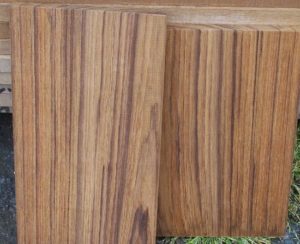
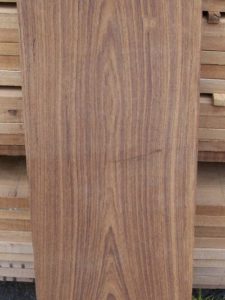
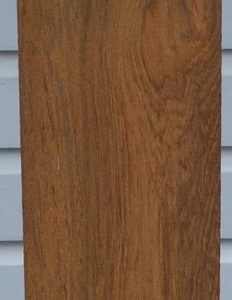
Now imagine if you freshly planed or sanded a Teak decking board and installed it on a sun drenched boat deck. That streaky color would stand out dramatically, but with all that direct sun exposure, within a very short period of time you would have a golden brown beauty begging to be complimented.
So what’s the moral of this story? Give your wood a sun tan, especially if it is Teak. Your customers will be much happier in the long run.

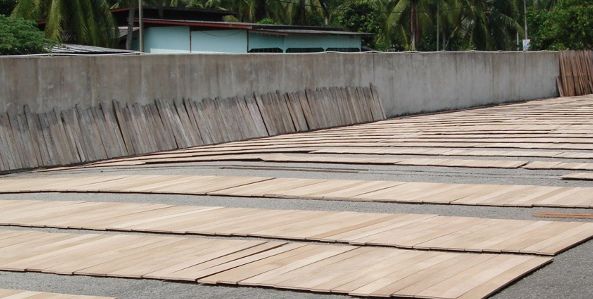
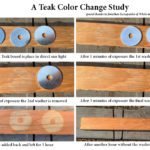


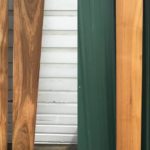
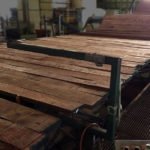
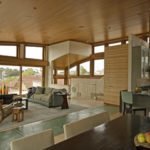


Help me please. One of the rails on our boat had an area where the layers of varnish peeled off in long strips. I used stripeze to get all the varnish off the entire rail. The color of the teak was revealed as red. I varnished it using spar varnish. It is obviously not yellow like the other rails. Why is this? Will it yellow over time after several coats of varnish?
The good news is that it doesn’t take very long for Teak to change color especially when it can get direct sun exposure. It is likely you are already seeing the color change while I write this. Now I am not real familiar with the stripping agent you used but more than likely you removed not just the varnish but all the oils and possibly a thin top layer of the Teak while scraping it off. There may also be some heavy metals in the stripper that are oxidizing causing the red hue. I would make sure you have removed all the stripper by wiping down the surface with something like mineral spirits or Naptha first. Then let it sun tan for a few days to a week to see how the color changes. Again, not knowing anything about the stripper you used I can’t be sure, but I would bet that the Teak will mellow in color and take on that yellow hue like the rest of your rails.
Should one delay applying finish until teak’s color stabilizes, as explained above? And does this restrict the type of finish one can apply? I am building some end tables and a bedframe and am considering a variety of finishes. Thanks.
No,the finish won’t really interfere with the process much at all. But I think you will also find that sticking the unfinished piece in the sun for a few hours will be enough to effect the color change.
Thank you for your efforts of disseminating important information related to timber. I was very much worried about seeing the streaky colour of my newly construction going on house door. Exactly door colour looks like what you have shown in that video. My painters have applied one coat of wood sealer on the door. What needs to be done to get golden yellow color. Shall I expose the door in sun light . Please advice me
Yes all you need to do is give it some sun and the colors will mellow out nicely. If you haven’t seen it yet, we did a video that shows this color change process in action. https://www.mcilvain.com/news/teak-color-streaks/
Hi
Thank You for hosting this site.
I am putting in a deck of African teak around a pool in the caribbean.
Can you advise on the process to finish the surface. Thanks
I would just use a decking oil. The wood is going to face harsh sunlight and weather conditions so no matter what the decking will fade and gray over the season and will need renewal once a year or once every two years. So the finish you choose should be about the ease of refinish more than anything. A hard film coating type of finish like a varnish will need to be stripped away each year and reapplied. Think about sailboats and the maintenance for their decking. Whereas a decking oil will soak in and condition the wood while adding a bit of UV protection. Here when it comes time to refinish, a light sanding (perhaps) and just reapply a few coats and you are back in business. The real key is choosing a good exterior wood first and you have already done that with the Afrormosia. I’ll bet it looks beautiful.
star brite teak oil says that it provides uv protection. if applied to teak, would it not slow down the color stabilization process? also, when cutting teak boards does the end grain need to be sealed as is the case with most woods?
Sure any finish will slow down the process. UV protection in a finish is just a higher solid count that will deflect and absorb UV. But the color will still change and mellow and I don’t think you will find that it slows it down that much as the large part of the color change is brought on by other chemical reactions. As far as sealing the Teak, it depends on how you are using it. If being used outside as a deck or similar sealing the ends of the boards is a good practice for ANY species of wood. Teak, because of the high oil content will fare better than others but it is still a good idea to seal the ends.